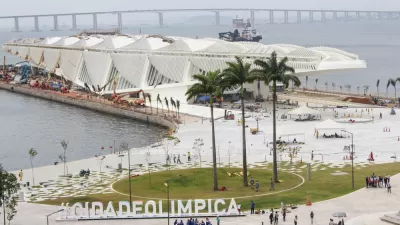This article from National Geographic looks at the construction boom that is rapidly changing the face of Beijing.
"Wang and his crew are part of an army of largely unskilled workers, more than a million strong, that has helped turn Beijing into what is perhaps the largest construction zone in history, with thousands of new projects under way. Once a flat cityscape dominated by the imperial Forbidden City and monumental but drab public buildings, Beijing has been struck by skyscraper fever. Over the past 30 years, China's economy has averaged nearly 10 percent annual GDP growth, driven by the marriage of world-class technology with a vast low-cost workforce. That same dynamic has turned China into an architects' playground, first in Shanghai in the 1990s as its skyline filled in with high-rise marvels, and now in Beijing, which is building at a mad pace in preparation for the 2008 Summer Olympic Games in August."
"Beijing's newest buildings push aesthetic and technological bounds, each outshimmering the last. Most major projects have been designed by foreign architects: Chinese clients crave innovation and hunt beyond China to get it, says American architect Brad Perkins, founder of Perkins Eastman in New York. During Mao's Cultural Revolution, architects were more technicians than artists (even the term architect was considered bourgeois), and private architectural firms were a rarity until a decade ago. 'By turning to foreigners like me,' says Perkins, 'the Chinese are buying 30 to 40 years of experience they didn't have.'"
FULL STORY: The New Great Walls

Planetizen Federal Action Tracker
A weekly monitor of how Trump’s orders and actions are impacting planners and planning in America.

San Francisco's School District Spent $105M To Build Affordable Housing for Teachers — And That's Just the Beginning
SFUSD joins a growing list of school districts using their land holdings to address housing affordability challenges faced by their own employees.

The Tiny, Adorable $7,000 Car Turning Japan Onto EVs
The single seat Mibot charges from a regular plug as quickly as an iPad, and is about half the price of an average EV.

Seattle's Plan for Adopting Driverless Cars
Equity, safety, accessibility and affordability are front of mind as the city prepares for robotaxis and other autonomous vehicles.

As Trump Phases Out FEMA, Is It Time to Flee the Floodplains?
With less federal funding available for disaster relief efforts, the need to relocate at-risk communities is more urgent than ever.

With Protected Lanes, 460% More People Commute by Bike
For those needing more ammo, more data proving what we already knew is here.
Urban Design for Planners 1: Software Tools
This six-course series explores essential urban design concepts using open source software and equips planners with the tools they need to participate fully in the urban design process.
Planning for Universal Design
Learn the tools for implementing Universal Design in planning regulations.
Smith Gee Studio
City of Charlotte
City of Camden Redevelopment Agency
City of Astoria
Transportation Research & Education Center (TREC) at Portland State University
US High Speed Rail Association
City of Camden Redevelopment Agency
Municipality of Princeton (NJ)



























